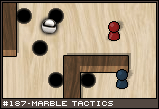| Three Hundred |
| - Index Page |
| - About... |
| - By Year |
| Collections |
| - Comp-Grid |
| - Procedural |
| - Tactics |
| - Tiny Crawl |
| - Misc |
| Previous | Mechanic #187 | Next |
![[labyrinth.jpg]](set10/img/entry187-labyrinth.jpg)
This is the old Labyrinth board game, in which you are attempting to get a small metal ball from one end of a maze to the other using two knobs that control the tilt of the board. If you can't track down the old wooden version, iOS has a few accelerometer-based derivatives. I bring up this classic game because this idea is basically about taking that tilting/ball rolling gameplay, and turning it into a tactical game.
![[marble1.png]](set10/img/entry187-marble1.png)
This is played on an open board with walls and holes, with your units being represented by wooden pawns. Players take turns activating a single pawn of their choosing, during which they can move/attack. To do this, replace the pawn with the metal ball. Tilt the field to move the ball around. Movement is over when the ball falls in a hole, leaves the field, or runs into another pawn (friend or foe). When the ball falls in a hole or off the field, just place the pawn at the edge of the hole/field. Attacking opponent's pawns is done by running the ball into them fast enough to cause them to move. Pawns are defeated by knocking them into holes or off the field (which means that placing your pawns next to holes is dangerous). If a pawn moves, the turn is over and remove the ball. Place the pawn down where the attacked pawn's original position is. That is, if you hit a pawn enough to move it, your pawn takes its place.
The basic idea is to roll into enemies and get them off the board, but you could also make it more interesting by breaking attacking and moving into two separate actions. Each turn, you can move OR attack. Movement is the same, except that pawns are now static and can not be pushed. Movement is purely about getting the ball to a new position. For attacking, you place the ball next to the attacking pawn as a sort of projectile that you fire at other pawns. The pawns are still static and can not be moved, and instead lose hit points based on how fast the projectile rams into them. Faster ball does more damage.
You can take it a step further by allowing special units and attacks. Here are some unit ideas: - Rubber Pawn - Balls that run into this pawn bounce off it. Damage is still done, but you lose control of the ball and could have it hit another units or fly into a hole. Place the Rubber pawns at strategic places to make movement difficult. - Sliding Pawn - These guys which slide slightly with the tilting board, even when it is not their turn. They won't move very far - they choose to stick within a small radius of their location - but makes them a minimally moving target that is difficult to hit or get around. - Bouncing Pawn - When hit, these guys will slide in the direction of momentum, sliding around the board, running into pawns and bouncing off walls. - Magnetic Pawn - When the metal ball goes near this pawn, it is attracted slightly towards it. This makes projectile attacks do more damage, but makes them more difficult to navigate near during a move. - Conjoined Pawn - Two pawns are connected by a rubber band. They move as one, so they move as two balls (still connected by the rubber band). Opponent attacks and movement bounce off the rubber band.
And here are some ball upgrades, to make things more interesting: - Wooden Ball - Not affected by magnets. Has more friction, so doesn't move as quickly but more easily navigated. - Giant Ball - Rather large ball. Too big to fall into holes, but also too big to fit through narrow spaces. - Multi-Ball - Instead of using a single ball for a projectile, place three balls in a line radiating out from the attacking pawn. These three balls are then used to attack. - Reverse Ball - Status effect. Up is down, left is right. - Tiny Ball - Does very little damage, but is small enough to navigate between holes easier. - Morning Star - A ball that is attached to the attacking pawn by a chain, swinging around automatically. Tilting moves the pawn around, swinging a metal ball of death.
|
